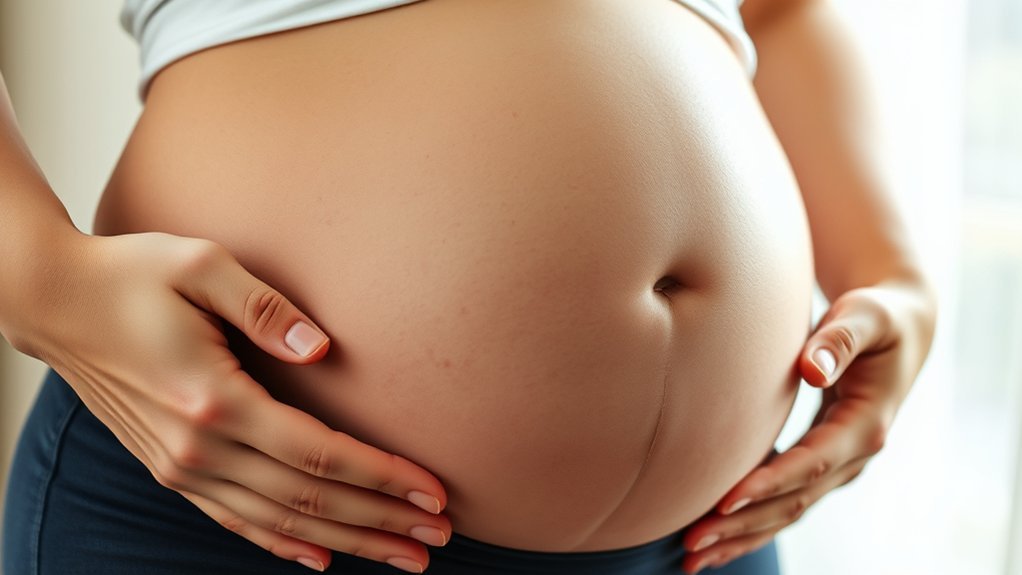Imagine your abdominal muscles as a bridge that’s slowly pulling apart. This separation, known as diastasis recti, is common during pregnancy and can lead to discomfort and instability. Understanding the symptoms and causes is essential for managing this condition effectively. With the right exercises and support, you can promote healing and regain strength. So, what steps can you take to address this issue and enhance your recovery journey?
What Is Diastasis Recti?
Diastasis recti is a condition where the rectus abdominis muscles—the ones that make up your “six-pack”—separate, often during and after pregnancy.
This separation can affect about 60% of women post-childbirth, but it can also occur in men and individuals with obesity or significant weight fluctuations.
You might notice a visible bulge near your belly button or a soft feeling in your midline, which can contribute to low back pain due to weakened abdominal muscles.
The severity of diastasis recti varies, with gaps ranging from mild to severe.
The severity of diastasis recti can differ, with gaps varying from mild to severe.
Early diagnosis is key. Engaging in targeted exercises for diastasis recti and seeking physical therapy can enhance your core strength and alleviate symptoms, improving both your physical and emotional well-being. Additionally, consulting with a specialist in pediatric health care can provide tailored advice and support for managing this condition.
Symptoms of Diastasis Recti During Pregnancy
As your pregnancy progresses, you might notice some unusual changes in your abdomen, including a visible bulge or ridge along the midline when you engage your core muscles. This could indicate diastasis recti, a condition marked by abdominal muscle separation of the rectus abdominis muscles. You may feel a soft or jelly-like sensation around your belly button and experience symptoms like lower back pain or difficulty lifting objects. Some women might even face pelvic floor dysfunction, affecting daily tasks.
| Symptom | Description | Impact on Daily Life |
|---|---|---|
| Visible bulge | Ridge along the midline during core engagement | Affects self-image |
| Soft belly button area | Jelly-like feeling indicating separation | May cause discomfort |
| Lower back pain | Discomfort due to weakened core stability | Limits mobility |
| Pelvic floor dysfunction | Difficulty in control or discomfort | Impacts daily activities |
Causes of Diastasis Recti
Understanding the causes of diastasis recti can empower you to take control of your body’s changes.
As your baby grows, the pressure on your abdominal muscles increases, and hormonal shifts make the connective tissue more flexible, leading to potential separation.
Factors like multiple pregnancies and obesity can also heighten your risk, so it’s important to reflect on these elements during your journey.
Hormonal Changes Impacting Muscles
Hormonal changes during pregnancy play an essential role in the development of diastasis recti, as they affect the strength and structure of your abdominal muscles.
Here’s how hormonal shifts influence your body:
- Increased levels of relaxin and progesterone soften and stretch your connective tissue, making it easier for your abdominal wall to separate.
- Higher estrogen levels impact collagen structure, reducing the tensile strength of the abdominal muscles.
- The linea alba thins and widens, allowing for greater expansion as your baby grows.
- If you’re carrying multiples, hormonal effects can be more pronounced, raising the risk of diastasis recti.
Understanding these hormonal changes can help you take proactive steps toward strengthening your core during pregnancy.
Pressure From Growing Baby
When you’re pregnant, the pressure from your growing baby can greatly impact your abdominal muscles, leading to diastasis recti.
As your uterus expands, it stretches the connective tissue, particularly the linea alba, which can weaken and separate. Hormonal changes during pregnancy soften this tissue, increasing the risk of separation.
Larger-than-average babies or excess amniotic fluid can further exacerbate the pressure on your abdominal wall, contributing to the severity of diastasis recti.
It’s crucial to be mindful of these factors, as they can notably affect your recovery postpartum. Understanding the causes helps you take proactive steps to support your abdominal muscles and minimize the risk of complications during and after your pregnancy.
Multiple Pregnancies and Obesity
The impact of multiple pregnancies on your abdominal muscles can be significant, especially when it comes to diastasis recti. Each pregnancy stretches your abdominal muscles and connective tissue, increasing the risk for developing abdominal separation.
Factors contributing to this include:
- Hormonal changes: They weaken your connective tissue, making it more susceptible to separation.
- Increased pressure: Carrying twins or triplets places even greater strain on your abdominal wall.
- Obesity: Extra weight adds pressure, raising the likelihood of diastasis recti.
- Higher BMI: Studies show that a higher body mass index during pregnancy correlates with more severe separation.
Understanding these factors can help you be proactive in addressing and managing diastasis recti during and after pregnancy.
Diagnosing Diastasis Recti

How can you tell if you have diastasis recti? Diagnosing diastasis recti starts with a physical examination by a healthcare professional, who assesses the abdominal separation between your rectus abdominis muscles.
You can also do a simple self-test: lie on your back with your knees bent, lift your head and shoulders, and check for a bulge or gap in the midline of your abdomen. If you notice a separation of two finger widths, it’s considered mild; three to four indicates more severe separation.
If you’re more than eight weeks postpartum and the gap persists, consult a pelvic physiotherapist for a thorough evaluation and a tailored treatment plan to address your specific needs.
Managing Diastasis Recti During Pregnancy
Managing diastasis recti during pregnancy involves using safe exercise techniques and maintaining good posture.
By focusing on engaging your core muscles and avoiding activities that put extra strain on your abdomen, you can support your body effectively.
Safe Exercise Techniques
Safeguarding your core during pregnancy is essential for effectively managing diastasis recti. To do this, focus on safe exercises that strengthen your core muscles without straining your abdominal wall.
Here are some techniques to incorporate:
- Pelvic tilts: These help activate your deeper abdominal muscles.
- Modified planks: They build strength while minimizing pressure on the rectus abdominis.
- Diaphragmatic breathing: This promotes core stability and engages the transverse abdominis.
- Consult a physical therapist: They can provide personalized exercise recommendations tailored to your needs.
Remember to avoid exercises like sit-ups and crunches, as they can exacerbate abdominal separation.
Prioritize your core’s health and adapt your routine as needed for a safer pregnancy experience.
Posture and Muscle Engagement
Proper posture plays an essential role in managing diastasis recti during pregnancy. You should focus on stacking your ribcage over your hips to reduce pressure on your abdominal wall.
As you stand or move, engage your lower abdominal muscles while avoiding ribcage flaring; this supports your growing belly and helps protect the linea alba. Incorporating diaphragmatic breathing into your routine can further engage your deep abdominal muscles and alleviate pressure.
When lifting, keep loads close to your body and use a log roll technique to minimize strain on your core. Regularly checking your posture during daily activities will help maintain core strength and stability, ultimately reducing the risk of worsening diastasis recti.
Exercises to Strengthen the Core
Strengthening your core is essential for managing diastasis recti, and there are several effective exercises to help you achieve this. Incorporate these movements into your routine for improved abdominal engagement:
- Pelvic Tilts: Flatten your lower back and activate deep abdominal muscles for stability.
- Abdominal Bracing: Draw your belly button toward your spine and hold for several seconds to enhance core strength.
- Modified Planks: Perform on your knees or with elevated arms to engage your core without straining your abdomen.
- Cat-Cow Pose: This exercise promotes spine mobility and encourages abdominal engagement.
These exercises won’t only strengthen your core but also support your recovery from diastasis recti during pregnancy. Additionally, strengthening your core can lead to improved health outcomes as highlighted in NICHD research initiatives.
The Role of Physical Therapy
When you’re dealing with diastasis recti, physical therapy can play an essential role in your recovery journey.
A pelvic physiotherapist can develop a personalized treatment plan that focuses on specific abdominal exercises and strengthening exercises tailored to your needs. These core exercises help heal the deep abdominal muscles and improve core stability, alleviating pain and enhancing your overall function postpartum.
Regular evaluations during physical therapy guarantee your exercise routine remains effective, adapting to your progress. Early intervention is key; it can prevent worsening of diastasis recti and support a smoother recovery process. Engaging in physical therapy not only promotes healing but also improves your quality of life during and after pregnancy, while also aligning with the focus on pediatric health information to ensure comprehensive care for new mothers and their children.
Modifying Daily Activities for Relief

To find relief from diastasis recti, modifying your daily activities can make a significant difference in your recovery. Here are some practical strategies:
- Log Roll Technique: Safely get in and out of bed by rolling onto your side, using your arms and legs to lift yourself, minimizing pressure on your abdomen.
- Exhale When Standing: When rising from a seat, exhale and engage your leg muscles to reduce strain on your abdominal wall.
- Avoid Heavy Lifting: If necessary, ask for help or use equipment designed for lifting to protect your abdominal muscles.
- Maintain Good Posture: Stack your ribcage over your hips and avoid leaning back to reduce abdominal pressure and separation.
Long-Term Outlook and Healing Process
While many women experience natural improvement in diastasis recti after childbirth, the healing journey can differ markedly from person to person. You might regain abdominal strength within weeks, while others may need months of a targeted exercise program.
Early intervention through consistent physical therapy greatly enhances your recovery, with around 90% of women seeing improvement if they start rehabilitation within the first year postpartum. Addressing diastasis recti early is essential, as untreated abdominal separation can lead to long-term effects like persistent lower back pain.
Surgical options are usually considered only after 6-12 months of conservative treatment. Focusing on your healing process now can lead to a stronger core and better overall function in the future.
Frequently Asked Questions
What Helps Diastasis Recti Pain During Pregnancy?
To alleviate diastasis recti pain during pregnancy, practice safe lifting, maintain good posture, and engage in gentle abdominal exercises. Supportive garments can help, and consulting a pelvic physiotherapist for tailored guidance is beneficial too.
Does Diastasis Recti Affect Birth?
Yes, diastasis recti can affect your birth. It may weaken your core, complicate pushing, and increase discomfort during labor. Seeking guidance from healthcare providers can help you manage these challenges for a smoother delivery.
Can an Obgyn Check for Diastasis Recti?
Yes, your OB-GYN can check for diastasis recti through a physical examination. They’ll measure the gap in your abdominal muscles and assess for any bulging, providing guidance on management and appropriate exercises tailored to your needs.
What Is the Fastest Way to Cure Diastasis Recti?
The fastest way to cure diastasis recti is through a tailored exercise program focusing on strengthening your core and pelvic floor. Avoid high-pressure activities, and consider consulting a physical therapist for personalized guidance and support.
Conclusion
In managing diastasis recti during pregnancy, you’re not just seeking relief; you’re nurturing your body and fostering recovery. By incorporating core-strengthening exercises, practicing good posture, and seeking physical therapy, you’re empowering yourself to heal. Remember, it’s about building strength, restoring stability, and embracing this transformative journey. With patience and dedication, you can alleviate symptoms, support your abdominal muscles, and ultimately enhance your well-being throughout pregnancy and beyond. Your commitment to self-care makes all the difference.
